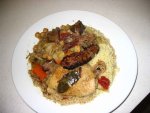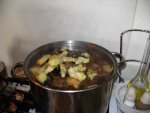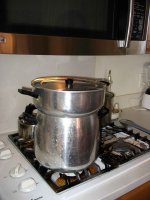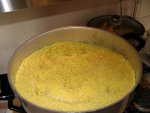 —c’est bon comme là-bas, dit !
—c’est bon comme là-bas, dit !
The term, couscous, refers to a pasta made from durum wheat semoulina. The result is tiny specs of pasta little bigger than the head of a pin. There is an excellent article on and illustration of couscous in Wikipedia. The length of this recipe should not intimidate you; there is a cultural and culinary context to establish, along with the wisdom and experience of failed attempts to convey. It is little more than an elaborate stew served over pasta.
This is a traditional North African Berber or Maghrebian dish greatly appreciated the last fifty years or longer in France. Other meats than those listed (you were thinking camel, right?) may be substituted, but it would be an aberrance to include pork which Islam forbids. Salt may be added to taste. No salt is included in this recipe because for most pallets, sufficient already occurs naturally in the various ingredients.
There are many ways to prepare couscous, many differences between locales. I have spoken at length to Tunisiens, Algerians and Moroccans all of whom told me their way was the only true one.
This dish is typically executed in a device known as a couscousier: a large pot over which sits a steamer holding the pasta. Sustitute a pasta cooker with the vegetable steaming basket up top for a close approximation.
The one improvement I would suggest over this way of cooking would be to cook the meat under carefully controlled conditions using my pot roast recipe and then serving the meat separately. This keeps you from losing the luscious collagen into the broth and the result is a much better meat to contribute to the dish.
Similarly, to get the best out of the chicken, follow the relevant parts of the chicken provençal recipe. Serve all these meats with the couscous at the end; get their juices into the pot well before the end of cooking the vegetables.
You may find yourself tempted to face East after eating this sumptuous feast!

Preparing the Meat
| 4-5 lbs. | chicken, cut into individual portions (drumsticks, thighs, half breasts, etc.) | |
| 3-4 lbs. | collar or shoulder of lamb cut into individual portions | |
| 2 lbs. | merguez sausages (optional, fried and served separately) | |
| 2 | large yellow onions, diced | |
| 2 cloves | fresh garlic, finely chopped (substitute dried garlic but don’t use garlic salt) | |
| 1½ lbs. | peeled tomatoes (fresh or bottled), sliced |
Brown the chicken and lamb well using ½ cup olive oil in an enameled cast-iron pot. Remove the meat leaving any rendered oil and fat in the pot. (Take care to keep the pot hot enough to brown the meat but not so hot as to blacken the oil and meat residues.) While still hot, fry the onions and tomatoes until the onions are blanched (but not black—reduce the heat). Drain the oil and rendered fat, leaving onions and tomatoes in the pot. Add the garlic.
Spices
| — | Laurel (bay leaf) | |
| — | Thyme | |
| — | Cloves | |
| — | Sage | |
| — | Green anis | |
| — | Fresh ground black pepper | |
| 1½ quarts | quarts of chicken stock |
Add the spices, broth and lamb to the pot.

Vegetables
| 3 large | carrots cleaned and cut rectangularly (rather than in coins) | |
| 2 | turnips, diced | |
| ½ lb. | chick peas (also known as garbonzo beans, found dried or canned) | |
| ½ lb. | fresh fine green beans (cut from 1 to 3 inches in length) | |
| 1 small | cabbage, blanched | |
| 1 large | eggplant | |
| 1 large | courgette (Zucchini squash) | |
| 2 lbs. | pumpkin coarsely diced (substitute yellow squash) | |
| 1 tiny | can of tomato concentrate or paste | |
| 2 large | artichoke hearts cut into quarters |
Add the vegetable ingredients in order. If purchased dried, the chick peas must be soaked for about 6 hours (or 1-2 hours in very hot water) and simmer for another hour before using. Blanche the cabbage in salted, boiling water for 10 minutes. Add the chicken on top of all the vegetables and cook on medium heat for 45 minutes. If using a couscousier, steam the pasta in the top over this mixture during cooking. The vegetables and broth must not touch the pasta during cooking. If the artichokes are fresh, add them to the other vegetables about 10 minutes before the end (don’t lose them). Remove them to add separately when serving.

Pasta
| 2½ lbs. | high grade pasta for couscous (usually available in import or ethnic food section of grocery) | |
| 1 quart | salty water (or a bit more depending the pasta) |
Moisten the pasta with the water (or just enough to cover it). Let it soak up this water for about 15 minutes, then process all of it by rubbing it between the hands to remove any lumps. Place the pasta in the top of the couscousier during the cooking process (see Vegetables), taking care never to let the vegetables and broth touch it. If no couscousier is available, improvise a steamer using a sieve and moistened cheesecloth over a deep pan, cook covered for 30 minutes.
To Serve
Pile the plate half-full of pasta. On the other half, place appropriate portions of chicken and lamb. Ladle a healthy portion of vegetables and broth over both halves; add the artichoke heart pieces. Optionally lay the merguez sausages over the pasta. Another option is to soak about half a pound of raisins in hot water for an hour and add them to the pasta as it is served. Offer harissa sauce, if desired; this may be imitated with Tobasco® or jalapeño peppers blended in a cup of the cooking broth. Serve immediately with steam still rising.
Notes
The recipe must obviously be sized to fit the couscousier; usually, it will be cut in half. This recipe will feed ten hungry persons; each should get at least one piece of each kind of meat and a piece of artichoke. To feed this many using a small couscousier or alternative method, perform the cooking process in two separate pots, in effect making two half batches at the same time. If the couscousier is one of the pots, cook that a little longer so that two batches of pasta may be steamed—warm the earlier one in the microwave at serving time.